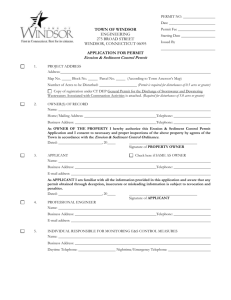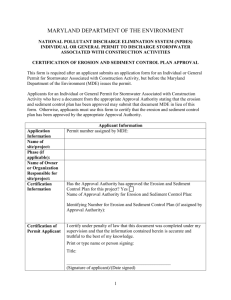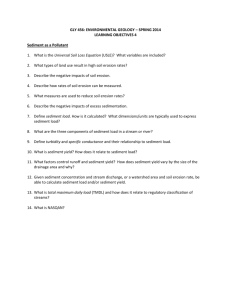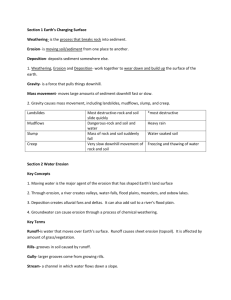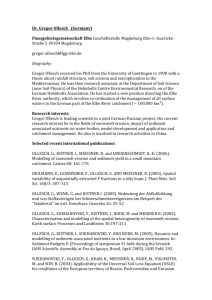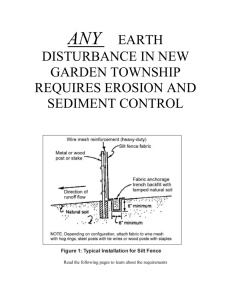Soil Loss Calculation Guidance 2015 April 9
advertisement
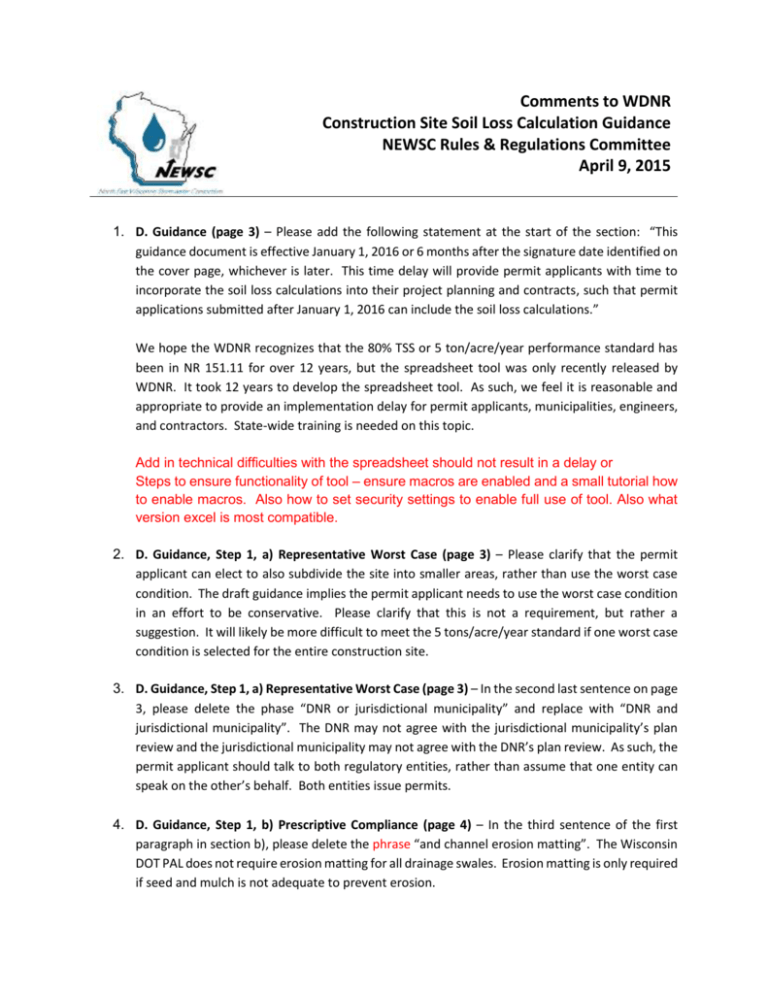
Comments to WDNR Construction Site Soil Loss Calculation Guidance NEWSC Rules & Regulations Committee April 9, 2015 1. D. Guidance (page 3) – Please add the following statement at the start of the section: “This guidance document is effective January 1, 2016 or 6 months after the signature date identified on the cover page, whichever is later. This time delay will provide permit applicants with time to incorporate the soil loss calculations into their project planning and contracts, such that permit applications submitted after January 1, 2016 can include the soil loss calculations.” We hope the WDNR recognizes that the 80% TSS or 5 ton/acre/year performance standard has been in NR 151.11 for over 12 years, but the spreadsheet tool was only recently released by WDNR. It took 12 years to develop the spreadsheet tool. As such, we feel it is reasonable and appropriate to provide an implementation delay for permit applicants, municipalities, engineers, and contractors. State-wide training is needed on this topic. Add in technical difficulties with the spreadsheet should not result in a delay or Steps to ensure functionality of tool – ensure macros are enabled and a small tutorial how to enable macros. Also how to set security settings to enable full use of tool. Also what version excel is most compatible. 2. D. Guidance, Step 1, a) Representative Worst Case (page 3) – Please clarify that the permit applicant can elect to also subdivide the site into smaller areas, rather than use the worst case condition. The draft guidance implies the permit applicant needs to use the worst case condition in an effort to be conservative. Please clarify that this is not a requirement, but rather a suggestion. It will likely be more difficult to meet the 5 tons/acre/year standard if one worst case condition is selected for the entire construction site. 3. D. Guidance, Step 1, a) Representative Worst Case (page 3) – In the second last sentence on page 3, please delete the phase “DNR or jurisdictional municipality” and replace with “DNR and jurisdictional municipality”. The DNR may not agree with the jurisdictional municipality’s plan review and the jurisdictional municipality may not agree with the DNR’s plan review. As such, the permit applicant should talk to both regulatory entities, rather than assume that one entity can speak on the other’s behalf. Both entities issue permits. 4. D. Guidance, Step 1, b) Prescriptive Compliance (page 4) – In the third sentence of the first paragraph in section b), please delete the phrase “and channel erosion matting”. The Wisconsin DOT PAL does not require erosion matting for all drainage swales. Erosion matting is only required if seed and mulch is not adequate to prevent erosion. 5. D. Guidance, Step 1, b) Prescriptive Compliance, Table 1 (page 5) – Please modify the Table 1 header and section iv text. NR 151.11 does not contain a maximum period of bare soil exposure for slopes exceeding 20%. The draft guidance implies that the maximum periods contained within Table 1 are a new regulatory requirement. Below are the only references to a maximum number of days identified within NR 151.11: NR 151.11(6m) requires that the permit applicant prevent or reduce the discharge of sediment eroding from soil stockpiles existing for more than 7 days. NR 151.11(8) requires temporary stabilization when land disturbing construction activities have temporarily ceased and will not resume for a period exceeding 14 calendar days. 6. D. Guidance, Step 2, b) Determine Compliance Period (page 5) – In the first sentence of the second paragraph in Step 2, please delete the phase “consecutive 12 month period” and replace with “calendar year”. The land disturbing start and end dates are part of developing a construction schedule and working toward compliance with the 5 tons/acre/year standard. NR 151.11 is a calendar year performance standard, not a consecutive month standard. The language in has historically been interpreted as a calendar year, this seems to imply a change to that inpretation. Please clarify. 7. D. Guidance, Step 5, Table 2 (page 7) – Please modify the erosion control efficiency for sod to 100%. Also, please add a new row to Table 2 for gravel, pavement, and roofs. Please identify these surfaces as 100% erosion control efficiency. 8. D. Guidance, Step 5, Table 3 (page 7) – Please add two new rows to Table 3 that identify a sediment removal efficiency that is higher than 80% for a sediment basin with polymer and a sediment trap with polymer. 9. D. Guidance, Step 5, Table 3 (page 7) – In the last row, please delete the phrase “sediment trap” and “1063”. Sediment traps are already identified in row two of Table 3. Based on Table 3, a ditch check practice is rated at 30% sediment removal and a sediment trap is rated at 80% sediment removal. In its current form, the last row contradicts the second row. C:\Data-nav\_NEWSC\Committee - R&R\Public Comment\RUSLE2\Soil Loss Calculation Guidance 2015 April 9.docx

